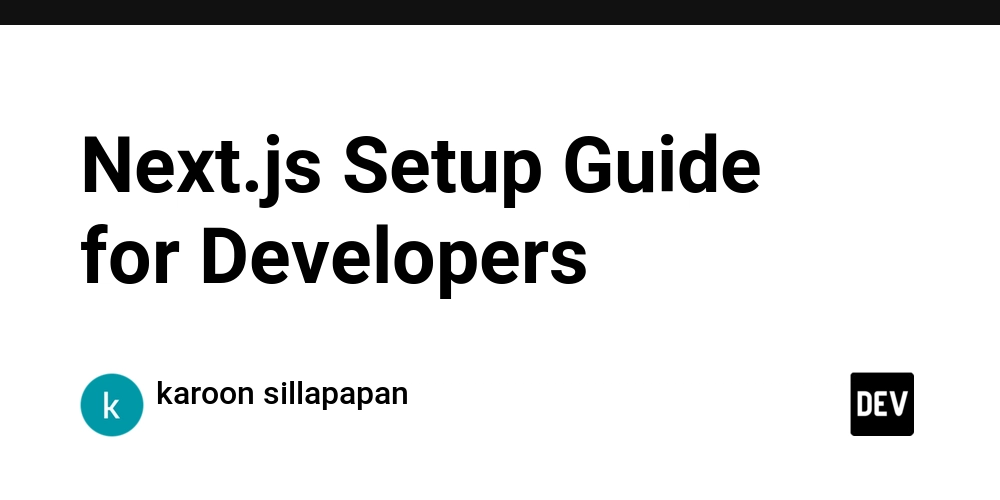Next.js Setup Guide for Developers
This Post provides a step-by-step guide for setting up the next-hello-world project using Next.js with TypeScript, creating a Git repository, and uploading your code for the first time. Table of Contents Creating a Next.js Project with TypeScript Creating a New Private Git Repository Setting Up Git Configuration for This Project Uploading Your Local Code to Git for the First Time Next Steps 1. Creating a Next.js Project with TypeScript Prerequisites Node.js 18.17 or later installed npm or yarn package manager Setting Up a New Next.js Project Run the following command in your terminal: npx create-next-app@latest next-hello-world You'll be prompted with several options. Here are the recommended choices for our project: Would you like to use TypeScript? › Yes Would you like to use ESLint? › Yes Would you like to use Tailwind CSS? › Yes (recommended for UI development) Would you like to use `src/` directory? › No Would you like to use App Router? › Yes Would you like to customize the default import alias (@/*)? › No These options create a modern Next.js project with: TypeScript for type safety ESLint for code quality Tailwind CSS for styling App Router (the newer, recommended routing system) Navigate to Your Project cd next-hello-world Install Additional Dependencies (Optional) You may want to add some common dependencies: npm install axios react-hook-form zod @hookform/resolvers Start the Development Server npm run dev Visit http://localhost:3000 to see your app running. 2. Creating a New Private Git Repository On GitHub Go to GitHub and sign in Click the "+" button in the top-right corner and select "New repository" Repository name: next-hello-world Description: Add a brief description of your project Select "Private" Do NOT initialize with README, .gitignore, or license (we'll push our existing code) Click "Create repository" After creating the repository, you'll see instructions for pushing an existing repository. Keep this page open as we'll need the repository URL in the next steps. 3. Setting Up Git Configuration for This Project Initialize Git in Your Project First, make sure you're in your project directory: cd path/to/next-hello-world Initialize Git: git init Configure User Information for This Project Only Set your name and email for this specific repository: git config user.name "Your Name" git config user.email "your.email@example.com" Note: This sets the configuration for this repository only. If you need to use different accounts for different projects, this approach ensures the correct identity is used. Verify Your Configuration Check that your settings were applied correctly: git config user.name git config user.email Add Remote Repository Connect your local repository to the remote one you created: git remote add origin https://github.com/username/next-hello-world.git Replace username with your GitHub username or organization name. Verify Remote Check that the remote was added correctly: git remote -v You should see your repository URL listed for both fetch and push. 4. Uploading Your Local Code to Git for the First Time Create a .gitignore File Next.js creates a .gitignore file automatically, but verify it exists and contains appropriate entries: cat .gitignore If needed, create or update it with: # Dependencies /node_modules /.pnp .pnp.js .yarn/install-state.gz # Testing /coverage # Next.js /.next/ /out/ /.swc/ next-env.d.ts # Production /build /dist # Misc .DS_Store *.pem # Debug npm-debug.log* yarn-debug.log* yarn-error.log* .pnpm-debug.log* # Local env files .env*.local .env .env.development .env.test .env.production # Vercel .vercel # TypeScript *.tsbuildinfo # IDE specific files /.idea # VSCode (ignore all except for recommended extensions and settings) .vscode/* !.vscode/extensions.json !.vscode/settings.json !.vscode/tasks.json !.vscode/launch.json *.sublime-* *.code-workspace # Cache .eslintcache .stylelintcache # Optional: if using Storybook /storybook-static # Optional: for SASS .sass-cache/ # PWA **/public/sw.js **/public/workbox-*.js **/public/worker-*.js **/public/fallback-*.js **/public/sw.js.map **/public/workbox-*.js.map **/public/worker-*.js.map **/public/fallback-*.js.map Stage Your Files Add all your project files to the staging area: git add . Create the Initial Commit Commit your files with a descriptive message: git commit -m "Initial commit: Next.js TypeScript project setup" Push to the Remote Repository Push your code to the remote repository: git push -u origin main Note: If your default branch is named master instead of main, use git push -u origin master instead.

This Post provides a step-by-step guide for setting up the next-hello-world project using Next.js with TypeScript, creating a Git repository, and uploading your code for the first time.
Table of Contents
- Creating a Next.js Project with TypeScript
- Creating a New Private Git Repository
- Setting Up Git Configuration for This Project
- Uploading Your Local Code to Git for the First Time
- Next Steps
1. Creating a Next.js Project with TypeScript
Prerequisites
- Node.js 18.17 or later installed
- npm or yarn package manager
Setting Up a New Next.js Project
Run the following command in your terminal:
npx create-next-app@latest next-hello-world
You'll be prompted with several options. Here are the recommended choices for our project:
Would you like to use TypeScript? › Yes
Would you like to use ESLint? › Yes
Would you like to use Tailwind CSS? › Yes (recommended for UI development)
Would you like to use `src/` directory? › No
Would you like to use App Router? › Yes
Would you like to customize the default import alias (@/*)? › No
These options create a modern Next.js project with:
- TypeScript for type safety
- ESLint for code quality
- Tailwind CSS for styling
- App Router (the newer, recommended routing system)
Navigate to Your Project
cd next-hello-world
Install Additional Dependencies (Optional)
You may want to add some common dependencies:
npm install axios react-hook-form zod @hookform/resolvers
Start the Development Server
npm run dev
Visit http://localhost:3000 to see your app running.
2. Creating a New Private Git Repository
On GitHub
- Go to GitHub and sign in
- Click the "+" button in the top-right corner and select "New repository"
- Repository name:
next-hello-world - Description: Add a brief description of your project
- Select "Private"
- Do NOT initialize with README, .gitignore, or license (we'll push our existing code)
- Click "Create repository"
After creating the repository, you'll see instructions for pushing an existing repository. Keep this page open as we'll need the repository URL in the next steps.
3. Setting Up Git Configuration for This Project
Initialize Git in Your Project
First, make sure you're in your project directory:
cd path/to/next-hello-world
Initialize Git:
git init
Configure User Information for This Project Only
Set your name and email for this specific repository:
git config user.name "Your Name"
git config user.email "your.email@example.com"
Note: This sets the configuration for this repository only. If you need to use different accounts for different projects, this approach ensures the correct identity is used.
Verify Your Configuration
Check that your settings were applied correctly:
git config user.name
git config user.email
Add Remote Repository
Connect your local repository to the remote one you created:
git remote add origin https://github.com/username/next-hello-world.git
Replace username with your GitHub username or organization name.
Verify Remote
Check that the remote was added correctly:
git remote -v
You should see your repository URL listed for both fetch and push.
4. Uploading Your Local Code to Git for the First Time
Create a .gitignore File
Next.js creates a .gitignore file automatically, but verify it exists and contains appropriate entries:
cat .gitignore
If needed, create or update it with:
# Dependencies
/node_modules
/.pnp
.pnp.js
.yarn/install-state.gz
# Testing
/coverage
# Next.js
/.next/
/out/
/.swc/
next-env.d.ts
# Production
/build
/dist
# Misc
.DS_Store
*.pem
# Debug
npm-debug.log*
yarn-debug.log*
yarn-error.log*
.pnpm-debug.log*
# Local env files
.env*.local
.env
.env.development
.env.test
.env.production
# Vercel
.vercel
# TypeScript
*.tsbuildinfo
# IDE specific files
/.idea
# VSCode (ignore all except for recommended extensions and settings)
.vscode/*
!.vscode/extensions.json
!.vscode/settings.json
!.vscode/tasks.json
!.vscode/launch.json
*.sublime-*
*.code-workspace
# Cache
.eslintcache
.stylelintcache
# Optional: if using Storybook
/storybook-static
# Optional: for SASS
.sass-cache/
# PWA
**/public/sw.js
**/public/workbox-*.js
**/public/worker-*.js
**/public/fallback-*.js
**/public/sw.js.map
**/public/workbox-*.js.map
**/public/worker-*.js.map
**/public/fallback-*.js.map
Stage Your Files
Add all your project files to the staging area:
git add .
Create the Initial Commit
Commit your files with a descriptive message:
git commit -m "Initial commit: Next.js TypeScript project setup"
Push to the Remote Repository
Push your code to the remote repository:
git push -u origin main
Note: If your default branch is named
masterinstead ofmain, usegit push -u origin masterinstead.
If the Push Fails
If your push is rejected because the remote repository has content that you don't have locally, you can use:
git config pull.rebase false
git pull origin main --allow-unrelated-histories
Resolve any conflicts, commit the changes, and then push again:
git push -u origin main
5. Next Steps
Now that your project is set up and connected to Git, here are some next steps:
Branch Strategy
Create a development branch for ongoing work:
git checkout -b development
git push -u origin development
Pull Requests
When working with a team, use pull requests to merge changes:
- Make changes in a feature branch
- Push the branch to GitHub
- Create a pull request to merge into development
- After review, merge into main for production












































































































































































![[The AI Show Episode 156]: AI Answers - Data Privacy, AI Roadmaps, Regulated Industries, Selling AI to the C-Suite & Change Management](https://www.marketingaiinstitute.com/hubfs/ep%20156%20cover.png)
![[The AI Show Episode 155]: The New Jobs AI Will Create, Amazon CEO: AI Will Cut Jobs, Your Brain on ChatGPT, Possible OpenAI-Microsoft Breakup & Veo 3 IP Issues](https://www.marketingaiinstitute.com/hubfs/ep%20155%20cover.png)




































































































































































































































































_incamerastock_Alamy.jpg?width=1280&auto=webp&quality=80&disable=upscale#)
_Brain_light_Alamy.jpg?width=1280&auto=webp&quality=80&disable=upscale#)






























































































![Senators reintroduce App Store bill to rein in ‘gatekeeper power in the app economy’ [U]](https://i0.wp.com/9to5mac.com/wp-content/uploads/sites/6/2025/06/app-store-senate.jpg?resize=1200%2C628&quality=82&strip=all&ssl=1)























































































